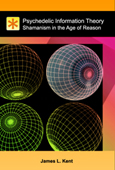
Search Results : brain
Showing 20 to 40 of 91
What is Nonlinear Hallucination?
... of information can be processed through the brain is via nonlinear analysis; linear attempts to formalize psychedelic nonlinear information into words or pictures typically fall short of capturing the holistic perspective. Nonlinear Hallucinat...
The Case Against the Spirit Model of Psychedelic Action
... proposes that psychedelics work by allowing the brain access to a spirit dimension where information can be passed and received. There will always be entheogen users who adopt the spirit model for personal reasons, but others may not find any use i...
Psi-verts and Psychic Piracy: The Future of Parapsychology?
... and responds to it. To illustrate, using brain mapping technology such as EEG a person in one room has their brain monitored while a person in a distant room has their brain randomly stimulated, usually through visual stimulation, such as a ...
... These effects seem to be a function of frontal brain areas.[33] Others have argued that the capacity of working memory is better characterized as the ability to mentally form relations between elements, or to grasp relations in given informatio...
... contain all the colors that the human eyes and brain can distinguish. Unsaturated colors such as pink, or purple variations such as magenta, are absent, for example, because they can only be made by a mix of multiple wavelengths. Visible wavele...
... and the number of distinct perceptions the brain can analyze at any one time. Despite functional limitations, human consciousness is seamless, meaning that each perception and behavior flows smoothly from one to the next. When consciousness is...
... procedures were used. As in rat brain, d-LSD was the most potent displacer of 3H-ketanserin specific binding with a Ki of 0.9 nM. The phenylisopropylamine DOI also displayed high affinity (Ki of 6 nM). Stereospecific interactions we...
...
The Jaguar That Roams the Mind
... healing of a woman suffering from a brain tumor. Culminating in a ceremony fraught with terror yet ultimately enlightening, Tindall’s journey reveals the crucial component missing from the metaphysics of the West: the understandin...
Uncoiling the spiral: Maths and hallucinations
... tell us something fundamental about how our brains are wired up. And it seems that they can. Geometric hallucinations were first studied systematically in the 1920s by the German-American psychologist Heinrich Klüver. Klüver's interest in ...
Vivid dreams, hallucinations, psychosis and REM sleep in Guillain-Barré syndrome
We conducted a prospective controlled study of the clinical and biological determinants of the mental status abnormalities in 139 patients with Guillain-Barré syndrome (GBS) and 55 patients without GBS placed in the intensive care unit (ICU controls...
... Consciousness, Hyperspace and Beyond Using brain Technology, Psychedelics and Altered-Mind States. Annotation: This book is unique in its detailed descriptions of using anitcholinergics and antihistamines in conjunction with REM suppressio...
Psychedelic Drugs Reconsidered
... plays an important role in the chemistry of the brain. They are called deliriants because their effects at high doses include incoherent speech, disorientation, delusions, an halucinations, often followed by depression and amnesia for the period of...
Sleep, dreams, and memory consolidation: the role of the stress hormone cortisol
... which is known to exert influence on many of the brain systems involved in memory. The concentration of cortisol escalates over the course of the night's sleep, in ways that we propose can help explain the changing nature of dreams across the sleep ...
... saw sleep as a passive condition where the brain is isolated from the other parts of the body. Alcmaeon claimed that sleep was caused by the blood receding from the blood vessels in the skin to the interior parts of the body. Aristotle suggest...
Sleep and General Anesthesia as Altered States of Consciousness
... stages of sleep each with its characteristic brain-wave activity. Stage 1 is the transition stage from wakefulness to sleep and is identified with theta waves and last between 1 to 7 minutes. In stage 2 EEG recordings show fast-frequency burst o...
... wakefulness while preserving several cognitive brain functions. Their main representatives are the a2-adrenergic agonists, such as clonidine or dexmedetomidine.12 The last category of altered states of consciousness refers to pathologic altered...
The stuff dreams are made of: anatomical substrates of REM sleep
... of the neurotransmitters of activated cells and brain lesions to determine the dynamics of the regulation of the REM sleep–generating system in the rat. Work in the cat3,4 has defined the location of ‘REM sleep–on’ neurons, cell...
The neuropsychology of REM sleep dreaming
RECENT PET imaging and brain lesion studies in humans are integrated with new basic research findings at the cellular level in animals to explain how the formal cognitive features of dreaming may be the combined product of a shift in neuromodulatory ...
... (ACh) is the primary messenger of the brain’s cholinergic system, essential to hippocampal modulation of memory compression and recall. Sleep-onset, sleeping, and dreaming are associated with an increase in ACh and cholinergic modulatio...
« Back 20 | Next 20 » Showing 20 to 40 of 91
